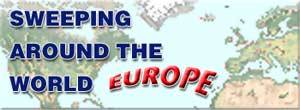
The Sweepers of Murren and Gimmerwald, Switzerland
by Ranger Kidwell-RossAlthough my stopover in the mountains of Switzerland was planned as strictly personal, while there I discovered information about a 'niche sweeping market' I had to pass along. First, let me set the scene:
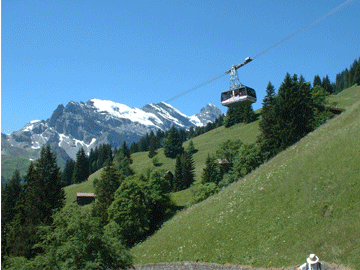 Our location are the towns called Gimmerwald and Murren, located a gondola ride a bit over halfway to the top of the Schilthorn summit and its Pia Gloria revolving restaurant. This is the mountaintop that was immortalized in the James Bond movie, On Her Majesty's Secret Service. The towns' elevation is about 1,650 meters, or 6,400 feet. Gimmerwald, the lower of the two by one gondola stop, consists of just a couple of hotels, including where we stayed at Walter's quaint Hotel Mittaghorn, and a few scattered houses.
Our location are the towns called Gimmerwald and Murren, located a gondola ride a bit over halfway to the top of the Schilthorn summit and its Pia Gloria revolving restaurant. This is the mountaintop that was immortalized in the James Bond movie, On Her Majesty's Secret Service. The towns' elevation is about 1,650 meters, or 6,400 feet. Gimmerwald, the lower of the two by one gondola stop, consists of just a couple of hotels, including where we stayed at Walter's quaint Hotel Mittaghorn, and a few scattered houses.
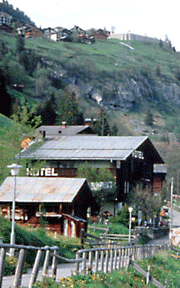 Murren is huge by comparison, since it boasts a few shops in addition to its lodging accommodations. Murren is also the highest altitude ski resort in this Swiss area. Across the valley are the towering trio of Eiger, Mšnch and Jungfrau mountains. We not only had to get there by gondola, but to get our car to the bottom of the mountain we traveled on a car transport train, a first for me.
Murren is huge by comparison, since it boasts a few shops in addition to its lodging accommodations. Murren is also the highest altitude ski resort in this Swiss area. Across the valley are the towering trio of Eiger, Mšnch and Jungfrau mountains. We not only had to get there by gondola, but to get our car to the bottom of the mountain we traveled on a car transport train, a first for me.
This area, called the Lauterbrunnen Valley, is considered the most impressive glaciated valley in the Alps and comprises one of the largest nature-protected areas in Switzerland. The area is home to 72 waterfalls, and there are numerous wonderful walks and hikes in a wild, romantic area. There are massive rock faces, cascading waterfalls and flower-filled mountain meadows to go along with the area's picturesque pastures and pure mountain air.
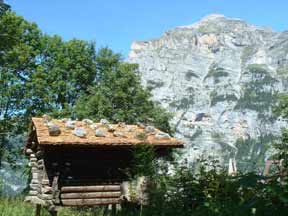 As you can see in the opening photo display, this is a place of incredible beauty in the summer and, I'm told, incredible storms, snowfalls and great skiing in the winter. As you can see from the picture on the left, rocks are even put onto the roofs of some of the buildings so the winter winds won't blow them off. Even for someone who has spent much of his life in America's Pacific Northwest, this area offered a unique near-to-nature experience I'll long remember.
As you can see in the opening photo display, this is a place of incredible beauty in the summer and, I'm told, incredible storms, snowfalls and great skiing in the winter. As you can see from the picture on the left, rocks are even put onto the roofs of some of the buildings so the winter winds won't blow them off. Even for someone who has spent much of his life in America's Pacific Northwest, this area offered a unique near-to-nature experience I'll long remember.
Populating many of the sidehill pastures are cows, each of which has a bell on its neck to assist in finding it when it gets lost. This makes for a quaint sound often wafting through the valley as one hikes. If anything, this adds to the quaintness of the area. And, this brings us ever-closer to the sweeping portion of our story.
If you weren't raised in the country you may not know that where there are cows there's always a need for hay, especially in a cold climate like Switzerland. Oh, and did I mention it's so steep that you'd think that by now the cows would have evolved so their legs on one side are a foot shorter than those on the other? And, believe it or not, that's where our story turns to a particular type of road sweeping unique, as far as I know, to Switzerland.
Farmers grow hay on the hillsides and then, because of the extreme steepness of the land, are forced to harvest it by hand. First, they use a walk-behind horizontal cutter. Then, after the hay has dried, apparently using some kind of threat unknown to the American parent population, they and their kids actually go up on the hillsides in the 90+ degree heat and rake up the majority of the hay by hand.
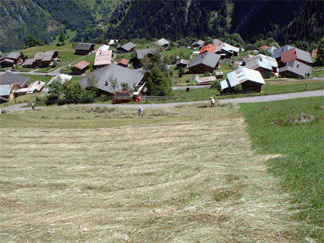
For about the first hundred feet above the road, which crisscrosses back and forth because of the land's steepness, they rake the hay downhill and into the road itself. For the rest, the hay is raked into about a 12 x 12 tarp that has ropes attached to the upper ends. These twin ropes are then attached to a single cable, and someone on the road above pulls each tarpload of hay up the hill via a gasoline-powered winch system. All of these tarploads of hay are deposited in the road above. Now is when we get to the sweeping part.
The farmers in the area all have a particular, specialized type of machine that's built to go along the road and sweep up all the hay via the use of rotating mechanical tines located on the back. This puts the hay into the enclosed 'hopper' of the sweeper, which is mounted on the back of the truck.
The tines may be raised or lowered, which allows the operators to compensate for relative road height as well as to raise the tines all the way and then pitchfork hay underneath the rotating tines so as to pick it up with the machine stationary. On board, they all carry a homemade-type broom that's used to gather any leftover material from the sides of the roads so they're kept tidy and clean after the sweep.
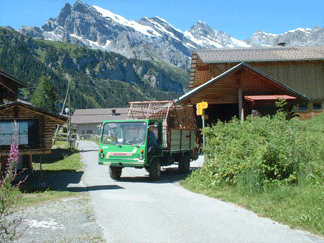 On some hillsides that aren't quite as steep, the operators inch the 'hay sweepers' slowly up the hillsides, looking all the while like the machine's couldn't possibly keep traction or are about to roll over. In those instances, the sweepers either rake the hay directly from the field or, more often, the workers bring the hay over to the machine.
On some hillsides that aren't quite as steep, the operators inch the 'hay sweepers' slowly up the hillsides, looking all the while like the machine's couldn't possibly keep traction or are about to roll over. In those instances, the sweepers either rake the hay directly from the field or, more often, the workers bring the hay over to the machine.
Although I was unable to get a photo of one of the machines actually sweeping while on the roadway, you can still see pretty much see from the photos how the machines operate. Besides, it's not like you'll probably have the need to go out and order one...
Even though this is probably information that won't help you do a better job in your own daily sweeping endeavors, I hope you enjoyed this introduction to an entirely different segment of the sweeping marketplace as much as I did. You can at least use it to threaten your kids with being sent to a Murren mountain farm in Switzerland if they don't take out the garbage!
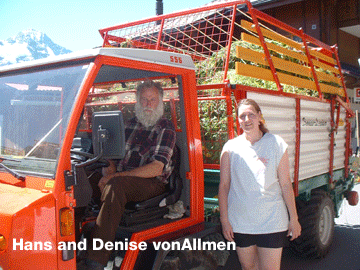
If you'd like, you may view a brief Quicktime movie taken in conjunction with the above story. Note you need to have either Quicktime or another plug-in viewer that will read a .mov file. The movie is advised for only high-speed connections, however, with a filesize of just over 27 megabytes.
| Our next stop is the historic city of Heidelberg, Germany, one of the only German cities left intact after the bombing of World War II. We meet with Heidelberg city officials to learn the secrets of success in this town that recently was honored with a European Certification of Distinction in the area of waste management. |
 |
 |
Back to Table of Contents for Sweeping in Europe
© 2005 - 2021 World Sweeper |